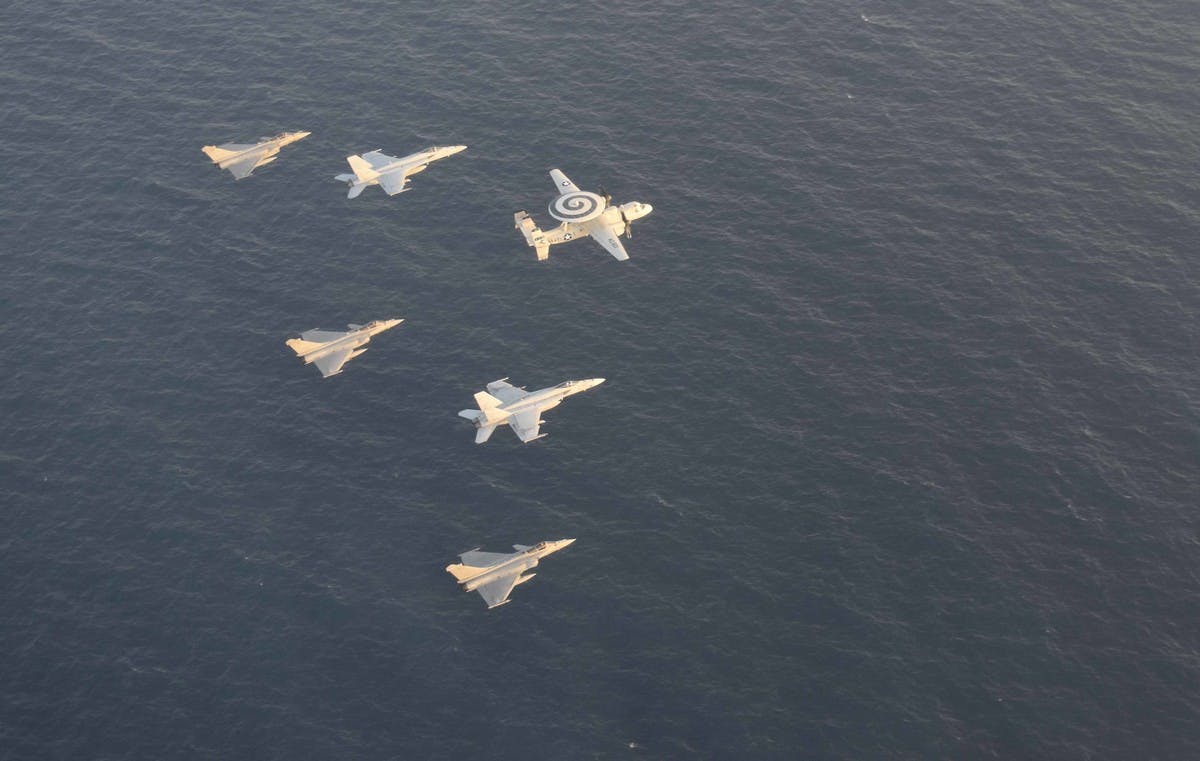100+ NATO Warplanes Inc. F-35, Rafale, Eurofighter, JAS-39 Gripen, Flex Muscles Over European Skies In Major War Drills

More than 130 NATO aircraft took to the skies over Europe this week in a major show of strength and coordination as part of the Ramstein Flag exercise.
The multinational drill, which took place in Greek airspace, involved fighter jets and support aircraft from over 12 NATO member nations, including the United States, the United Kingdom, France, Greece, Italy, and Poland.
Ramstein Flag is designed to enhance air combat readiness and cooperation among NATO forces, underscoring the alliance’s commitment to maintaining peace and stability in the Euro-Atlantic region.
The exercise is part of NATO’s broader strategy to ensure rapid-response capability in an evolving global security landscape.
A recent NATO Air Command tweet noted the scope of the Ramstein Flag exercise: “During Ramstein Flag over 130 fighter and enabler aircraft from Greece, Canada, France, Hungary, Italy, Poland, Portugal, Romania, Spain, Sweden, UK, and the USA, along with NATO AWACS, RQ-4D drones, and a deployable air surveillance center, took part in Ramstein Flag.”
Key participants in the exercise included NATO’s Airborne Warning and Control System (AWACS) and RQ-4D surveillance drones, which provided vital airborne command and surveillance capabilities.
Additionally, a deployable NATO air surveillance and control center played a crucial role in coordinating complex air operations across multiple countries.
Colonel Alexandros Chalkopoulos of the Hellenic Air Force, who flew in a Greek F-16 during the mission, praised the exercise’s success.
AfriPrime App link: FREE to download...
“The execution of this highly complex demonstration was a true testament to the agility of our Allied pilots, coordinating precision skills from twelve nations in this fighter formation flight. We conducted the mission at almost half-time of the Ramstein Flag execution,” said Colonel Alexandros Chalkopoulos.
“The participating Allies have demonstrated their close relationship during the mission today, the same spirit on display in the demanding scenarios the exercise planners have developed for Ramstein Flag in Greece,” he added.
Ramstein Flag 2024
The Ramstein Flag exercise is a key component of NATO’s broader initiative to bolster air combat readiness and ensure seamless coordination among its member nations’ forces.
This large-scale training exercise highlights NATO’s capacity to project power across multiple countries while reaffirming its commitment to maintaining stability and peace in Europe.

By conducting joint drills under realistic combat scenarios, NATO’s air forces enhance their ability to address potential crises and safeguard the collective defense of member nations.
The exercise, which ran from September 30 to October 11, 2024, marked the inaugural iteration of the ‘Flag’ series, demonstrating NATO’s determination to execute its ‘Deter and Defend’ strategy.
This initiative is critical in ensuring NATO’s ability to deter aggression and defend its territories in the Euro-Atlantic region.

A wide variety of advanced aircraft participated in the exercise, including F-35s, Mirage 2000s, Rafales, F-16s, Eurofighters, JAS-39 Gripens, MQ-9 Reapers, Rivet Joint surveillance planes, and airlifters like the C-130 and A400.
Among the participating forces were US Air Force F-35A Lightning IIs from the 48th Fighter Wing, stationed at RAF Lakenheath, and KC-135 Stratotankers from the 100th Air Refueling Wing, based at RAF Mildenhall.
Additionally, members from the 19th Electronic Warfare Squadron, part of the USAFE-AFAFRICA Warfare Center at Ramstein Air Base, Germany, contributed to the training by simulating realistic air threats.
The exercise took place primarily from the airbases in Greece’s West Peloponnese region, with Andravida serving as the main hub. Some aircraft operated from their home bases across Europe, demonstrating NATO’s ability to integrate forces across borders.
The missions included both day and night sorties, providing comprehensive training opportunities for NATO aircrews and allowing aviation enthusiasts to observe the action.
Additionally, NATO AWACS aircraft from Geilenkirchen, Germany, were deployed to their Forward Operating Base at Aktion/Preveza Air Base in northwestern Greece.
These aircraft played a vital role in command and control operations, helping to manage the complex Integrated Air and Missile Defense (IAMD) and Counter Anti-Access/Area Denial (C-A2AD) scenarios.
Crews from 17 NATO nations served as airborne battlespace managers, coordinating Allied aircraft during the drills.
Under Allied Air Command, NATO’s Combined Air Operations Centre (CAOC) in Torrejón, Spain, led the planning, coordination, and monitoring of air operations.
CAOC is responsible for safeguarding southern European airspace and overseeing special air policing missions over Albania, Montenegro, North Macedonia, and Slovenia, ensuring the security of NATO’s southern flank.
AfriPrime App link: FREE to download...
- Questions and Answers
- Opinion
- Story/Motivational/Inspiring
- Technology
- Art
- Causes
- Crafts
- Dance
- Drinks
- Film/Movie
- Fitness
- Food
- Games
- Gardening
- Health
- Home
- Literature
- Music
- Networking
- Other
- Party
- Religion
- Shopping
- Sports
- Theater
- Wellness
- News
- Culture
- War machines and policy

